LIXIL makes pioneering water and housing products that solve everyday, real-life challenges, making better homes a reality for everyone, everywhere.
- Global Site
-
- English
- Japanese
- Brand Sites
Global
- Global Site
-
- English
- Japanese
- Brand Sites
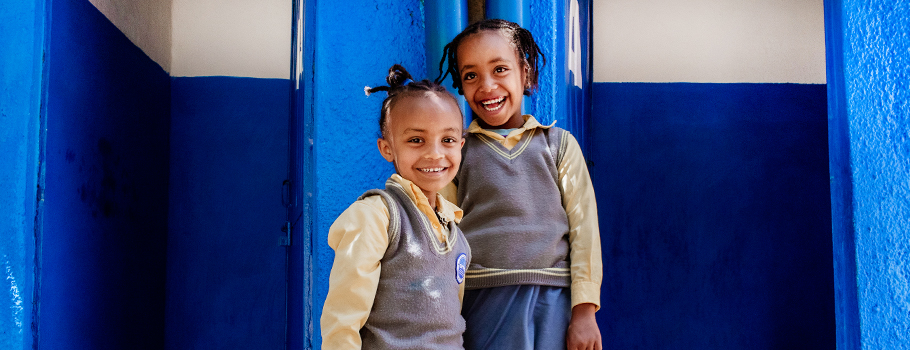
What comes to mind when you think about the facilities that are vital to running a school?
Classrooms with desks and chairs? Libraries? Computer rooms? Toilets are probably not high up on the list. And yet for students around the world, inadequate sanitation is a daily reality.
In parts of Sub-Saharan Africa, many schoolchildren use open pit latrines, which can be unsanitary and unsafe, with children at risk of falling in and injuring themselves. These facilities provide little privacy and a handful of toilets are often shared by hundreds of students.
This makes focusing on learning a constant challenge and has a big impact on attendance. Some schools report children missing whole lessons1 after joining long queues for the toilet. Many teachers and students end up avoiding the facilities altogether1, using nearby bushes instead. And women and girls are particularly affected2 – in Africa, half of young girls who drop out of education do so because their school doesn’t have basic toilets.
“Waking up in the morning, many people don’t really think about where they go to the toilet. But that is not the case for everyone,” says Samuel Langat, Leader Africa at SATO, a social impact business offering affordable and innovative sanitation and hygiene solutions.
“There needs to be equitable access to sanitation and hygiene. It is a human right.”
Equal Access to Sanitation
Improving global water, sanitation and hygiene (WASH) is vital to making progress on many of the world’s challenges, not least the spread of communicable diseases.
But to meet the UN Sustainable Development Goal 6 target of safely managed water and sanitation for all by 2030, the world needs to speed up progress on sanitation3 by five times, the UN says.
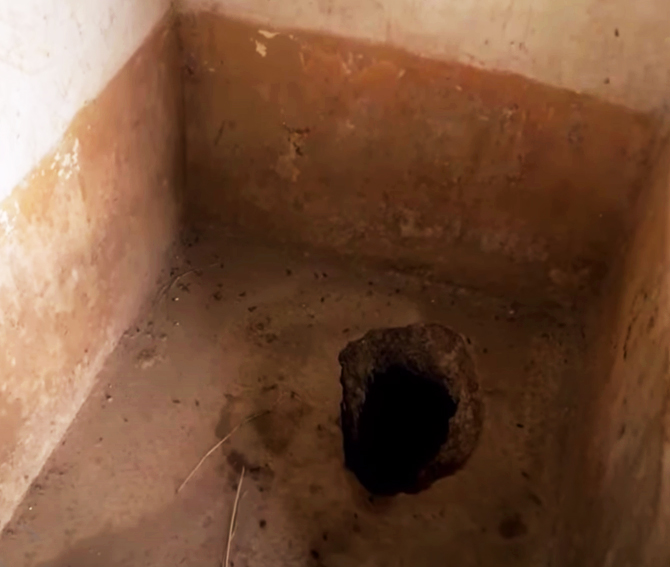
Example of pit latrine at a primary school in Kenya before SATO toilet systems were installed.
Just under half the world’s population – 3.5 billion people – lacked safely managed sanitation in 2022, and 2 billion people lacked basic hand washing facilities.
It is an acute problem in schools, too, affecting nearly one in three schools worldwide4. Sub-Saharan Africa, in fact, is one of two regions in the world where basic sanitation and hygiene services in schools remains under fifty percent5. In the areas where Langat works, he notes, as many as 200 students can share one toilet, demonstrating how underserved schools are.
Langat believes that improving school sanitation can have an amplifier effect. More than learning facilities, they are often focal points of a local community that can influence many outcomes and have wide-ranging positive impacts on its people.
“Sanitation is like a key that opens the door to so many other good things,” Langat says. “It unlocks so many other SDGs that are the foundation for a prosperous life.”
Empowering Communities Through Schools
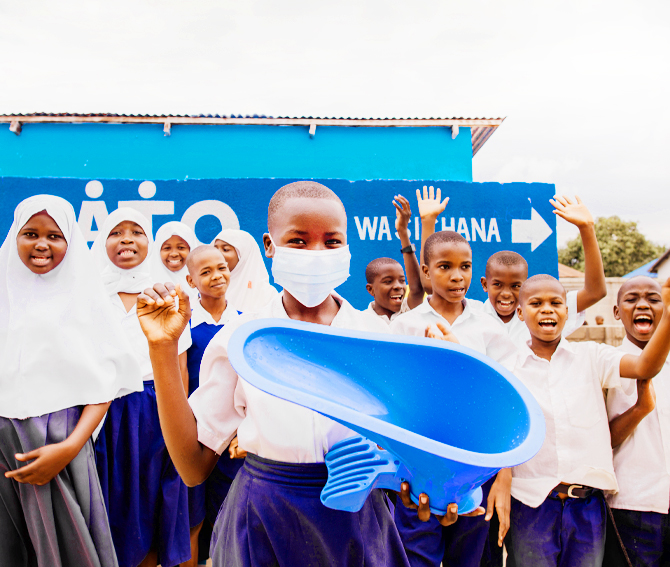
In 2020, SATO launched the School Toilet Enhancement Program (STEP) to upgrade toilets in Tanzania, Kenya, Ethiopia, Uganda, Rwanda, Nigeria. New facilities include easy-to-clean, affordable toilet pans with a self-closing trap to prevent odors and insects passing through.
So far, 68,000 children in 51 schools have gained access to safe toilets through STEP – but the benefits are far wider reaching, helping to demonstrate the impact of improved sanitation in local communities.
One of the first hurdles to improving broader sanitation is raising awareness of the issue and making affordable products readily available for communities. Spreading knowledge about the importance of good hygiene and sanitation and of the options available to achieve this is key.
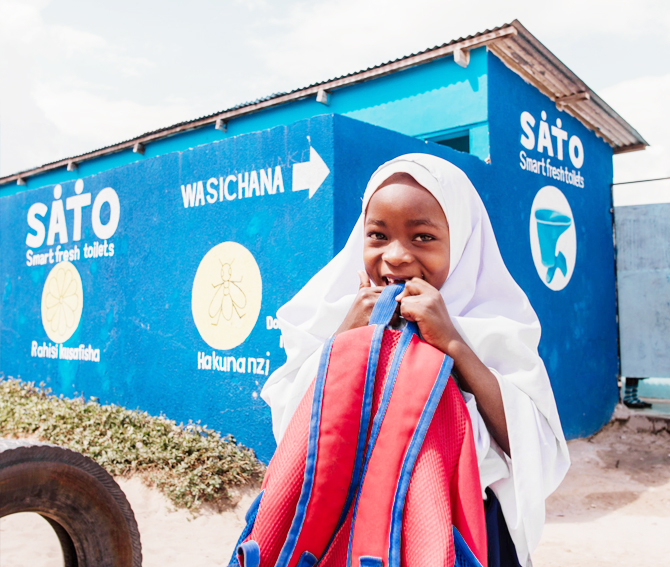
“Children are serving as champions,” Langat says. “They go home and talk about the toilets in their schools, and we see households coming and asking about them as a result.”
In turn, parents are helping to spread the word about the importance of good hygiene and sanitation. And as a result, other schools and people in the community are installing similar systems.
Schools are also central to many communities, Langat explains, serving as venues for events such as weddings and meetings of elders, meaning messages about and benefits of improved sanitation can reach many people. One way to drive awareness is inviting community members to the school for the toilet handover ceremony, where they can learn more about products and how to buy them.
In Rwanda, for example, after a handful of schools upgraded their facilities, the government rapidly saw the benefit and within a year had paid to upgrade nearly 90 schools.
Wider-reaching Solutions for Communities
Improving sanitation more broadly, however, requires wide-ranging solutions to address everything from product supply to financing. A key issue facing these communities, for example, is affordability.
For many people living day-to-day on small household budgets, improving sanitation isn’t immediately affordable or a priority. Even community leaders who recognize the need to improve sanitation in schools may have difficulty accessing appropriate financial services. And because of the low cost but potentially high risk of default, many financial institutions are unwilling to make loans, Langat says.
As part of its approach, SATO has partnered with financial institutions, such as FINISH Mondial, that help provide micro-financing products for individuals and local businesses. Underserved communities might not have the finances to cover the costs of improved sanitation out of their own pockets in one transaction, but by linking them with institutions they are able to take out a loan they can repay in monthly installments. At the same time, financing can help provide working capital for the individuals building and installing the upgraded systems.
“Sanitation is not just about the toilets themselves,” Langat says. “It encompasses innovation, financing, public-private partnerships, and many other things.”
Catalyzing Change
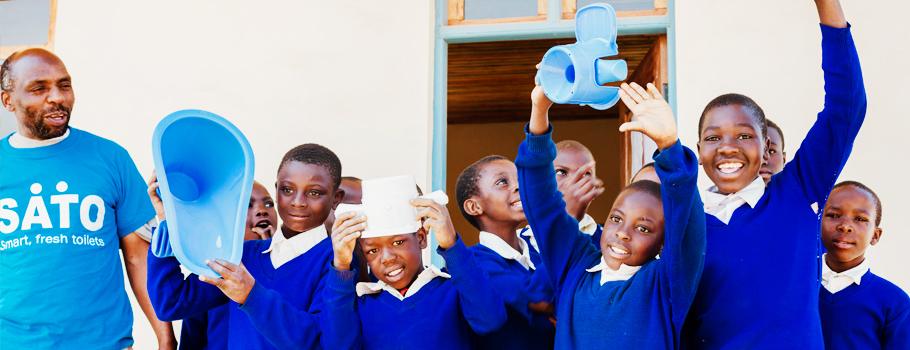
Investing in improved sanitation at schools can make a difference to a child’s health, education and future. But in many regions of Sub-Saharan Africa, where schools serve as a hub for local communities, it can have a catalyzing effect helping to empower communities.
But this is just a step in the right direction, Langat believes. To scale the program and help improve sanitation more broadly, partners, whether in the private sector, NGOs, or government, and investment are required. There are also opportunities for local business development, such as in operating and maintaining facilities, that ensure solutions are sustainable.
As Langat says: “The demand is so huge. We have the technology to change lives, but we need more collaboration and resources across the board – all hands need to be on deck if we are to accelerate sanitation at the rate needed.”
SATO Toilets Pans Installation in Mwea - Kenya (video):
Our Stories
- Backing People and Passions to Drive Innovation
- How Toilets in Schools are Catalyzing Change in Communities
- Building the Future by Recycling the Past
- Reinventing Consumer Connections in the World's Largest E-commerce Market
- Tackling Household Water Inefficiency in a Water-Stressed World
- Plugging the Plumber Shortage
- Pioneering Solutions to a Sewage Crisis in Rural Alabama
- Meet the Citizen Developers Changing How We Work
- Design and Brand Identity Transformation at LIXIL
- Three Changes to Prepare Europe’s Sanitary Industry for Growth
- Three Steps to Creating an Inclusive Culture
- From Linear to Circular: Giving Products in Your Home a New Lease of Life
- Crafting Unique Experiences as well as Products
- GROHE X: A Digital Brand Experience
- Design-led Innovation Delivering True Value
- Responsible Use of Plastics
- Empowering our People for an Agile Future
- Turning the Waves of Change into Opportunities
- SATO Tap: a New Handwashing Solution for All
- New Ways of Working Take Flight at LIXIL
- INAX: Rituals of Water
- Refreshing our sanitation targets, standing firm on our commitments
- Developing Attractive and Differentiated Products
- Conserving Water: The New Normal
- Insulating For a Warmer and Healthier Home
- Open Kitchen, Open Communication
- Tackling Open Defecation in India
- Shaping the Future of Faucets, One 3D Layer at a Time
- Bathed in Culture and Tradition
- Remodeling the Housing Market
- LIXIL's AQUA CERAMIC makes bathroom stains a thing of the past
- The Technology of Water
- Tackling Challenges in Global Sanitation and Hygiene
